Aquila Constellation in drawings - Illustrations
Aquila Constellation in Pictures
In the original article "Aquila Constellation" many of the illustrations are shown using JavaScript, as a result, they may not be displayed on all devices, on this page all images are presented for viewing.
Google translator 2022, January, original text: Aquila Constellation (Russian)
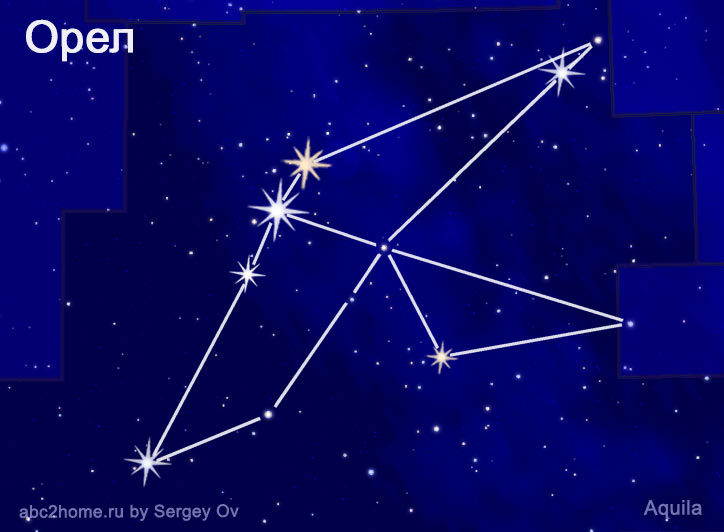 Aquila constellation
Aquila constellation
Fig. 1.Aql . Aquila constellation, diagram
The constellation Aquila (Aql) is the most ancient constellation of the Hercules group,[1]- more than 3000 years ago, the Ancient Babylonians represented the image of the Aquila in the pattern of the stars of the constellation.
The line of the celestial equator divides the constellation Aquila into two unequal parts, most of which belongs to the Northern Hemisphere, so it can be classified as a northern equatorial constellation.
In the areal ranking of the entire celestial sphere the Aquila is twenty-second (22nd place), and among the constellations of the Northern Hemisphere it takes the thirteenth place (652 sq. degrees) after the constellation Auriga.
The constellation Aquila borders on nine constellations - this is Sagitta, Hercules, Ophiuchus, Serpens Cauda, Scutum, Sagittarius, Capricornus, Aquarius and Delphinus.
Aquila on the territory of Russia is a setting, fully visible constellation (declination from -11.9° to 18.7°).
The constellation Aquila falls into the midnight culmination in the middle of summer and stays in it for a whole month - from the beginning to the end of July (right ascension from 18h 41m to 20h 38m ) , as a result of which the Aquila is considered a summer constellation.
At the latitude of Moscow, the Orel constellation is completely visible from February to December.
The boundaries of the constellation and most of the visible stars are shown in Figure 2.Aql - view of the constellation Aquila at the moment of culmination (it is customary to represent constellations in astronomy in this perspective):
Fig. 2.Aql. Constellation Aquila. Historically established and approved by the IAU (IAU) names of the most conspicuous stars.
With the help of this drawing, you can practice in constructing the contours of the Aquila constellation, if you move the cursor to Figure 2.Aql , the stars and only the stars will be visible. To enlarge the image of the stars of the constellation to full screen, click on the picture.
Fig. 2.1 Aql. Aquila constellation - Aquila stars. With the help of this drawing, you can practice drawing the contours of the constellation Aquila
Altair, Alpha Aquila, a white hot A7 main sequence star lies 16.8 light-years from the Sun, a distance just over the 5 parsecs (16.308 light years) of the Solar System's near-environment sphere specified by the Astronomical Union.
Altair has not yet entered the inner circle, but is currently approaching the solar system with a radial velocity (RV) -26,1 km/s.
The speed of approach of Altara and the Sun is mainly determined by the proper motion of the Sun relative to the nearest stars, the velocity vector of this motion is directed towards the constellation Hercules, and is deviated from the direction to Altair by a very small angle (Fig. 3.Aql).
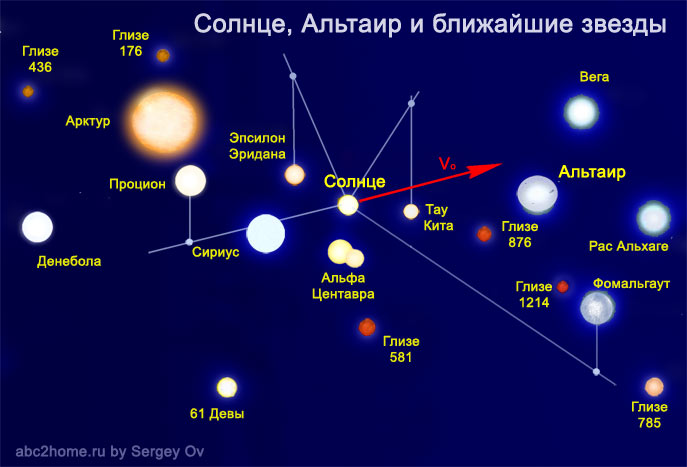
Fig. 3.Aql. Altair, the Sun and nearby stars
In about 6000 years, Altair will officially become a star in the near environment of the solar system.
Altair is a middle-aged star for its class (about a billion years) with a high metallicity compared to the Sun (high content of elements heavier than helium).
Altair as well as its bright neighbor in the summer triangle Vega (fig. 3.Lyr) very quickly rotates around its axis. At the equator, the rotation speed is estimated at 200 km / s (the rate of destruction of the surface of the star is 450 km / s). For comparison: the rotation speed at the equator of the Sun is slightly more than two kilometers per second (7284 km/h ≈ 2 km/s). Altair rotates a hundred times faster than the Sun and therefore has the shape of a flattened ellipsoid of revolution with a diameter ratio of 22% (fig. 4.Aql).
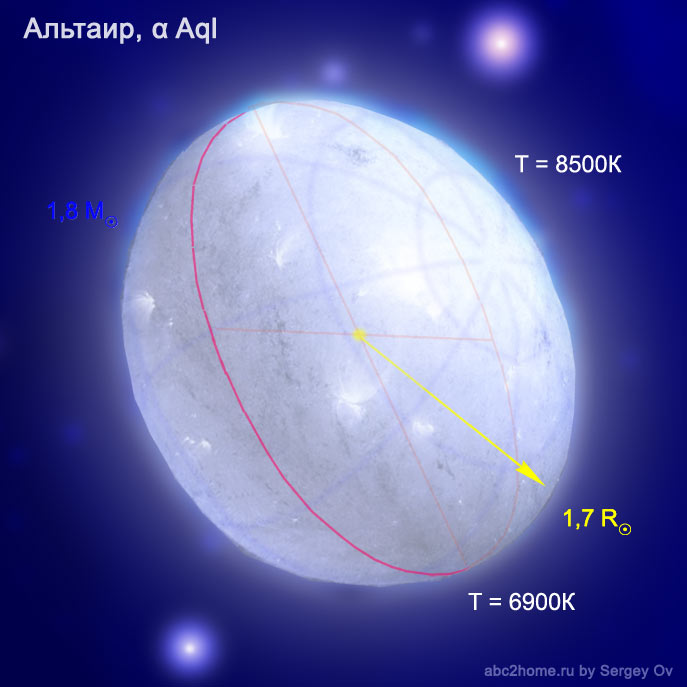
Fig. 4.Aql. Altair, α Aql - drawing based on CHARA interferometer data
Fortunately for the solar system, our very close neighbor Altair has a mass of about 1,8 M⊙ and will never become a supernova, its hydrogen supply should be enough, according to various estimates, for about another billion years, after which it will become a red giant.
As the main scheme of the star drawing of the Aquila , the most proportionally close to the original image of a soaring eagle was chosen, although here there is a violation of the boundaries of the constellation, but no one will say that this is a chicken or a pterodactyl (Fig. 5.Aql):
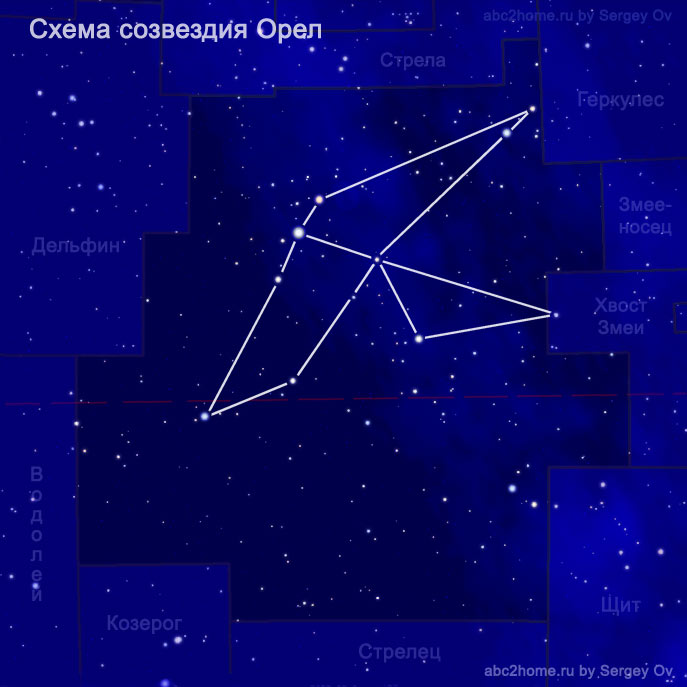 Sergey Ov
Sergey Ov
Fig. 5.Aql. Constellation Aquila. Soaring Aquila Star Chart (outline image)
The author's version of the chart by stars ( contour image ) of the eagle.
The schematic visualization of the Aquila by the stars, shown in Figure 5.Aql, is already used to depict the constellation Aquila on the planetarium map: "Starry sky of Russia".
Figure 6.Aql shows four alternating schematics of the Aquila stars that can be found during the constellation's culmination:
Fig. 6.1.Aql. Eagle with a quiver of Zeus, scheme S. Ov
Fig. 6.2.Aql. Pterodactyl
Fig. 6.3.Aql. Stymphalian Bird
Fig. 6.4.Aql. Girl with pigtails and a skipping rope, scheme S. Ov
Drawings 6.Aql. Variants of schematic images from the stars of the constellation Eagle - view at the culminating position of the constellation
It is interesting to see how ideas about the constellation Aquila have changed from the time of Claudius Ptolemy to the present day - it is precisely this evolution of the constellation that is illustrated by the first three schematic images of Figure 7 .Aql
Fig. 7.1.Aql. Eagle, diagram by K. Ptolemy
Fig. 7.2.Aql. Eagle, scheme by Jan Hevelius
Fig. 7.3.Aql. Eagle, diagram by H. Ray
Fig. 7.4.Aql. Stingray
Drawings 7.Aql. Drawings from the stars of the constellation Aquila
No less fruitful for drawing up schematic drawings is also the East-West direction.
Figure. 8.Aql пpresents a set of schematic images of stars that can be imagined when looking at the constellation, turning to the east:
Fig. 8.1.Aql. Shade or sugar bowl, scheme S.Ov
Fig. 8.2.Aql. Bow "Butterfly", scheme S.Ov
Fig. 8.3.Aql. Heron, scheme S.Ov
Fig. 8.4.Aql. Cauldron (kettle or bowler hat), scheme S.Ov
Drawings 8.Aql. Drawings from the stars of the constellation Eagle, when viewed from east to west
When looking at the constellation Eagle in the direction from north to south, a modern observer can imagine a sailing yacht as an image that fills the allocated area to the maximum, ski fans can see a skier on a springboard, fantasy lovers can see a dragon, and gamblers can see an ace of spades in a series of drawings 9.Aql:
Fig. 9.1.Aql. Sailboat, scheme S.Ov
Fig. 9.2.Aql. Skier on the springboard, scheme S.Ov
Fig. 9.3.Aql.Whelp (Little Dragon), scheme S.Ov
Fig. 9.4.Aql. Peaks, blame (slades), S.Ov scheme
Рисунки 9.Aql. Schematic drawings constructed when looking at the constellation Aquila from west to east
If you look at the constellation Aquila from west to east, then the largest drawing that fills almost the entire space of the constellation is the pastoral image of a girl with a sickle (Fig. 10.Aql ):
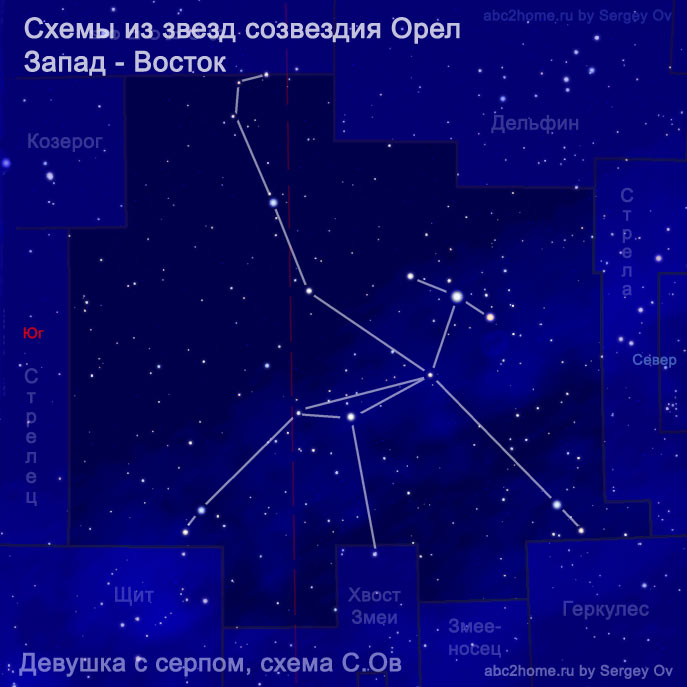 Sergey Ov
Sergey Ov
Fig. 10.Aql. Girl with a sickle - a schematic drawing of the stars of the constellation Aquila
The pictorial possibilities of the constellation Aquila, of course, are not limited to the drawings presented here, there is still a sufficiently large reserve for the flight of the pictorial imagination of readers. Send schematic drawings to the forum!
For observers of the starry sky of primary school age:
The best time to observe the constellation Eagle is in the second half of summer, just during school holidays. But even in September, and even in November, the Eagle can be seen in the evening in the western part of the starry sky. In summer, when ascending currents of warm air rise with the earth warmed by the sun, it is a pleasure to fly kites, but in the constellation Eagle there is a kite that you don’t even need to fly, the main thing is to be able to see it (fig. 11.Aql):
Fig. 11.1.Aql. Kite, scheme S.Ov
Fig. 11.2.Aql. Drawing of a kite
Рисунки 11.Aql. Kite - an image of lines connecting the stars of the constellation Aquila
In order to see the image of the Kite, you need to turn to the east, it is most convenient to consider the drawing of the constellation, when, after sunrise, its lower edge is far enough off the horizon line. By the way, all the drawings presented in this section should be viewed facing east.
When drawing 11.Aql almost all the brightest stars of the Eagle were used, if you carefully move the cursor to the edge of the picture, you can see a beautiful kite playing with all the colors of the rainbow .
Another well-remembered drawing of lines between the brightest stars is a portrait of an Alien Insectoid (ant):
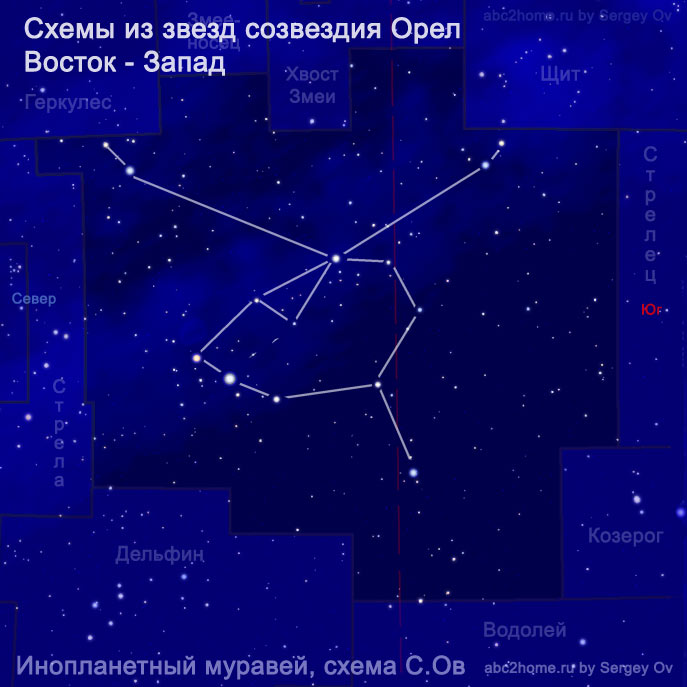 Sergey Ov
Sergey Ov
Fig. 12.1.Aql. Alien ant (insectoid): Trunks - a diagram of the stars of the constellation Aquila
Fig. 12.2.Aql. Alien Ant: Trunks drawing from the book
Fig. 12.Aql. Alien ant (insectoid): Trunks - line drawing between the stars of the constellation Aquila
A portrait of an insectoid thranx from Alan Dean Foster's fantasy series of novels "The Adventures of Flinx", as well as a fragment of an illustration for the publication of the book from this series "The End of Matter".
Readers who have already visited the pages of the site dedicated to other constellations have probably noticed in many of them images of fluffy creatures from the feline order. A rapidly growing gallery of stellar drawings of cats, cats and kittens, prompted the idea:
- What if stellar cats are hiding in every constellation?
And it was decided to test this idea in the further description of the constellations and thereby prove, so to speak, the theorem "On the habits of stellar cats and cats".
Theorem:
In every sufficiently large constellation, a "Star Cat" can lurk
And for those who are familiar with Lewis Carroll's fairy tale "Alice in Wonderland" the following axiom will be clear:
In any constellation you can find traces of a Cheshire Cat smile.
«I often saw cats that did not smile,” thought Alice. - But a smile without a cat! It's the most incredible thing I've seen here ."
( Lewis Carroll. Alice in Wonderland.
Chapter Six. Pig and Pepper. )
This axiom is easily confirmed - you don't have to look for the traces of the Cheshire Cat's smile for a long time, it hides in the Eagle's wings (Fig. 5.Aql).
The cat in the constellation Aquila was found when looking from east to west (And what else!) , its image is shown in Figure 13.Aql:
Fig. 13.1.Aql. Star Cat - a diagram of the stars of the constellation Eagle
Fig. 13.1.Aql. Cat that walks by itself, cartoon drawing
Fig. 13.Aql. Star Cat that walks by itself - drawing from the stars of the constellation Aquila
To make sure it's really the same cat, move the cursor over the drawing or touch it on the touch screen and you will see an image of a black cat with a white chest from the cartoon "The Cat Who Walked By Himself", based on Rudyard Kipling's fairy tale " The Cat That Walked Where He Wanted" ("The Cat That Walked by Himself").
Star Cat in the constellation Aquila found. The theorem is confirmed.
Asterisms of the constellation Aquila
The most ancient asterism[4] of the constellation Eagle could be considered the star drawing of the fiery sword of Shamash, if we are sure that the Ancient Sumerians could afford to realize the divine things separately of the god.
Figure 14.Aql shows the star pattern of the fiery sword of Shamash as an asterism, most of which falls on the modern borders of the Aquila constellation:
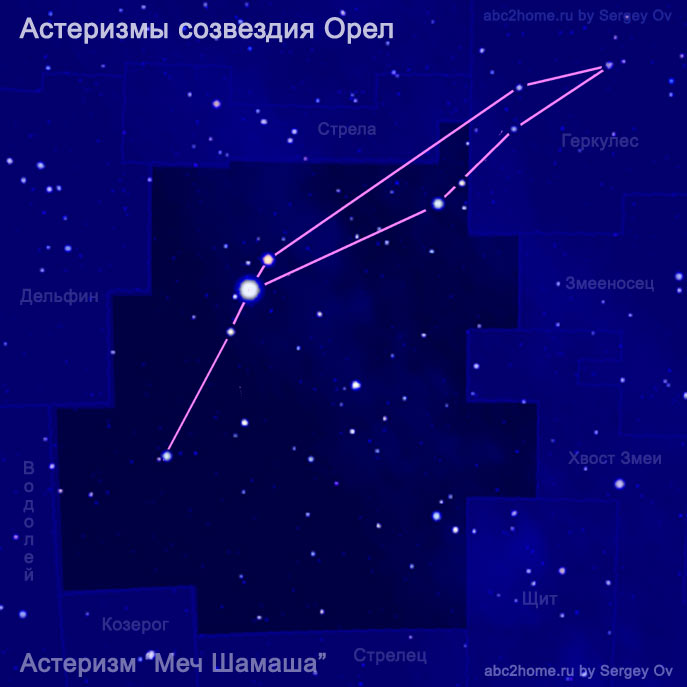 Sergey Ov
Sergey Ov
Fig. 14.1..Aql. "Fiery Sword of Shamash" - a diagram of lines connecting the stars of the constellation Aquila
Fig. 14.2.Aql. "Eagle of Ashur" - an image from the lines connecting the stars of the constellation Aquila
Drawings 14.Aql. The most ancient asterisms "Fiery Sword of Shamash" and "Eagle of Ashur" - images from the lines connecting the stars of the constellation Eagle
On the image 15.Aql. a series of not so ancient, but well-remembered asterisms is presented, with the help of which the constellation Aquila is easily recognized:
Fig. 15.1.Aql. Asterisms Family of Aquila and the Scales
Fig. 15.2.Aql. Asterism Trident
Fig. 15.3.Aql. Asterism Rhombus
Fig. 15.4.Aql. Asterism Wings of an Aquila
Fig. 15.Aql. Drawings of asterisms from the stars of the constellation Aquila:
Asterisms can be constructed in the form of drawings from stars, both within a constellation, and based on the brightest stars from several different constellations.
The constellation Aquila acts as a co-founder of the seasonal asterism Summer Triangle (Summer-Autumn).
Altair (α Орла; 0,77m) is the southernmost and second brightest star of the Summer Triangle (Fig.18.Aql):
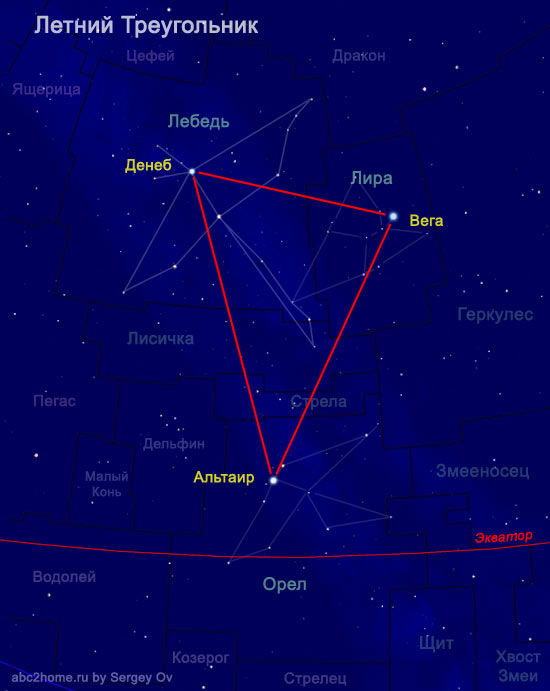
Fig. 16.Aql. Seasonal asterism Summer Triangle
How to find the constellation Aquila
Since the constellation Aquila is a setting constellation, it is important to have lines of sight from well-known non-setting constellations to determine its location.
The Aqula constellation was lucky in this regard - the main starting points for its search are the constellations Ursa Major and Cassiopeia (Fig. 17.Aql ):
Fig. 17.Aql. How to find the constellation Aquila from the constellations Ursa Major and Cassiopeia that do not set in the middle latitudes
(When copying the figure, please keep its numbering from the original article Fig. 17.Aql - " Constellation Aqula ", a link to the original is required.)
The only exact hit in Altair is obtained with the help of the stars of the Great Square of the constellation Pegasus (Fig. 18.Aql ):
Fig. 18.Aql. How to find the constellation Aqula using the stars of the constellation Pegasus
Unfortunately, from the bright stars of the neighboring constellation Cygnus, it is not possible to build lines of sight leading to the bright stars of Aquila, and it becomes very valuable to find the constellation Aquila using the stars of Lyra ( Fig. 19.Aql ):
Fig. 19.Aql. How to find the constellation Aqula using the stars of the constellation Lyra
Now it remains only to correctly determine the angular dimensions of the constellation Aqula. In Figure 20.Aql, the constellation is shown in that position, so it can be seen overhead on a summer or autumn evening, turning to the south or southwest.
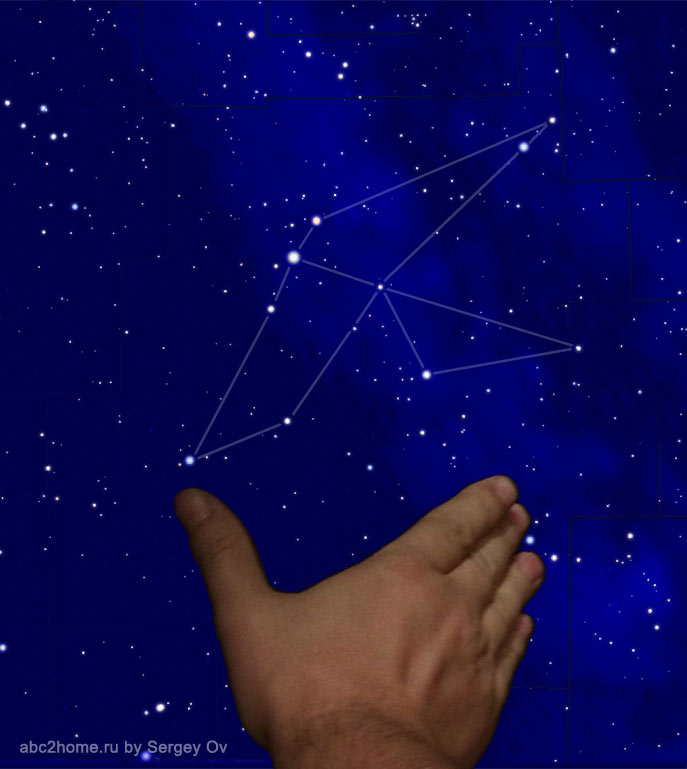
Fig. 20.Aql. Estimation of the angular size of the constellation Aquila using an outstretched hand
History and mythology of the constellation Aquila
The first artifacts associated with the region of the sky occupied by the modern constellation Eagle can be attributed to the III millennium BC. In particular, a relief drawing on a cylindrical stone seal dating from 2400 - 2300 BC ( Seal of the scribe Edda ) .
A photograph of an imprint on clay depicting Enki and his symbolic companions Capricorn and the bird Imdugut, surrounded by the gods of light forces friendly to him, Two-Faced Isimudpa and the Sun-God Shamash, is shown in Figure 21.Aql:
Mirroring such a sketch returns it to the possibility of projecting the night sky onto the earth's view. The results of the mirror reflection of a fragment of the print impression are shown in Figure 22.Aql:
Fig. 22.Aql. Sun-God Shamash with Fire Sword
Through several iterations of the scale of Figure 22.Aql , we managed to find a pattern of stars that is well compatible with the image of the Sun-God Shamash. It turned out that the divine celestial image takes the place of 7 modern constellations: Capricorn, Eagle, Hercules, Ophiuchus, Serpent, Scorpio and Sagittarius.
The compatibility of the image of Shamash on the seal of Edda with the drawing of the starry sky is clearly shown in Figure 23.Aql:
Fig. 23.1.Aql. Image of Shamash with a Fiery Sword - a schematic drawing of stars
Fig. 23.2.Aql. Combination of the map of the starry sky and the image of Shamash with the Fiery Sword
Fig. 23.3.Aql. Combination of the map of the starry sky with the names of modern constellations and the image of Shamash with the Fiery Sword
Drawings 23.Aql. An enlarged fragment of an impression of a stone seal (The seal ADDA) . The picture is shown in mirror image. Combination of the map of the starry sky and the image of Shamash with the Fiery Sword.
An example of the modern Assyrian iconography of the God Ashur, created on the basis of ancient symbolism, is shown in Figure 24.Aql.
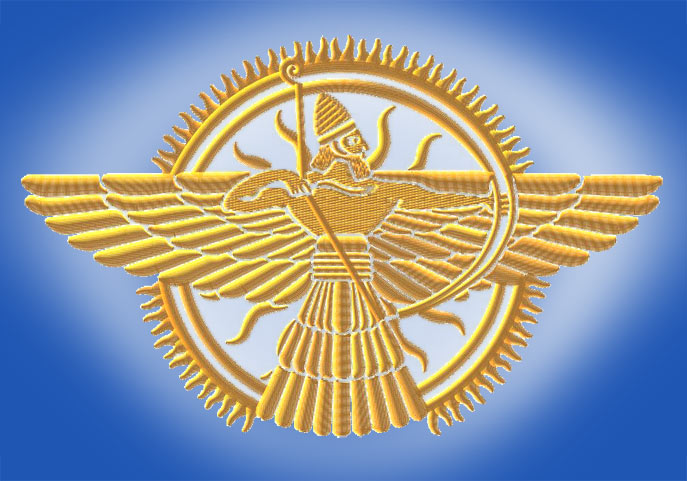
Fig. 24.Aql. The Assyrian god Ashur is a collage based on contour sketches of ancient relief images of Ashur
The Persian astronomer as-Sufi (Abu-l-Hussein Abdurrahman ibn Umar as-Sufi) in the 10th century AD in his "Book of Fixed Stars"{2}, following Ptolemy, represents the prototype of a sitting eagle. At the same time, according to the local Eastern tradition, there is a soaring eagle in this place, and as-Sufi depicts a motionless eagle with spread wings (Fig. 25.Aql):
Fig. 25.Aql.The constellation Eagle in al-Sufi's Book of the Fixed Stars (Al Sufi. Book of the constellations, or fixed stars. - Bodleian copy: Suwar al-Kawakib al-Thabitah (Book of fixed Stars) - a copy written by al-Sufi's son 1009 in Iran)
In the atlas of Jan Hevelius "Uranography", published in 1690, two constellations are depicted in the place of the modern constellation Eagle - the constellation Eagle itself, with the image of a soaring bird in an unusual perspective, and a drawing of a very young Antinous.
The constellation Antinous was proposed in the second century AD in honor of the deceased favorite of the Roman emperor. Since this constellation is not in the "classical" list of constellations of Ptolemy's Almagest, many astronomers simply did not recognize this constellation, and even more did not approve of the passions associated with its appearance.
The drawing of the constellation is illustrated by a collage created on the basis of a painting from the atlas of Jan Hevelius, by mirroring it, to give the appearance "from inside the celestial sphere":
Fig. 26.Aql.The constellation Eagle - a collage based on a drawing in the atlas of Jan Hevelius ( only those stars that were entered by Hevelius himself in the atlas and are located on the figure of the Eagle are highlighted )
Sergey Ov (Seosnews9)
Illustrations for the article: The constellation Aquila (Aql) - the most ancient constellation of the Hercules group
Separate pages with illustrations:
Perseus constellation in the drawings
Cygnus constellation in the pictures
Aries constellation in the drawings
Lyra constellation in the pictures
Aquila constellation in the drawings
1. The group of Hercules will include the constellations:
Cugnys, Lyra, Hercules, Vulcepula, Sagitta, Aquila, Scutum, Serpens, Ophiuchus.
Fig. 16. Hercules constellations family
The constellations Hercules, Ophiuchus, Serpens are united by a common mythical plot, and so to speak, the Scutum, Sagitta, Lyra, Vulpecula and the Aquila "crept into the group" got here mostly due to common borders. The Cygnus was probably added to the group because its brightest star is the pinnacle of the seasonal asterism "Summer-Autumn Triangle" (Altair-Deneb-Vega), as well as due to the existence of the myth of the Stymphalian birds and the myth of Orpheus, which unites the constellations Lyra and Cygnus.
When I first met the groups of the constellations Ursa Major (10 constellations) and the Zodiac (12 constellations) created by Donald Menzel, I just quietly rejoiced: “Well, I found a way to better remember the constellations!”.
I was glad when it came to the group of Perseus constellations (9 constellations) and the Orion group (5 constellations) - everything is compact and logical.
And now the turn came up to the Hercules group proposed by Menzel: 19 constellations, which are half scattered in different parts of the sky - this is not something to remember, it is inconvenient to search!
Therefore, it was decided that in the future the Menzel’s list of the Hercules group should be divided into two groups - northern and southern: for the northern group, we will retain the old name “Hercules group” (9 constellations or 10 if we count the tail and head of the Snake separately), and for the southern one - for now a working title is proposed: "Centaurus group" its list of constellations will probably still need to be edited.
Hercules is the Roman name for the ancient Greek hero Hercules. In the mythological plot set forth here, we restrict ourselves to a list of exploits suitable for our northern Hercules constellations family:
The myth of the exploits of Heracles / lat. Hercules / (summary)
When Hercules was still a baby, Hera, the wife of Zeus, learning about an illegitimate child, sent two snakes to him. The snakes were supposed to strangle the baby, but Hercules showed remarkable strength and himself strangled the snakes by grabbing them by the throat -the constellations Ophiuchus and Serpens can display this scene.
When the matured Hercules was forced to perform his exploits in the service of King Eurystheus, the fourth of them was the expulsion of the Stimphalian birds from the Peloponnese Peninsula - in some sources the role of the Stimphalian birds is assigned to the constellations Aquila, Cygnus and Lyra.
The constellation Hercules and the constellation Dragon located above represent the scene from the last twelfth feat of Hercules: the moment when Hercules-Hercules is trying to lure the Dragon guarding the Hesperides garden to treat him with a club is captured on the canvas...
Google translator, December 2019
2. Asterism - a group of stars, forming a characteristic pattern and having an independent name. Asterism can be as part of a constellation, for example, Tron, and combine several constellations, for example, the Summer Triangle.
3. Navigation stars are the stars used in navigation and aviation to determine the position of ships and airplanes in the event of a technical failure. Currently, the stars listed in the “Marine Astronomical Yearbook” are classified as navigational.
4. The photosphere is the deepest and densest layers of the star's atmosphere (including the Sun), from which the main share of the energy emitted by it comes out.
5. Right ascension and declination - the name of the coordinates in the second equatorial frame of reference
6. The proper motions of stars — the apparent angular displacements of stars in the celestial sphere for the year.
Great Soviet Encyclopedia, 3 ed. 1969 - 1978
● Home
 Zodiac signs
Zodiac signs
 Constellations
✔ Aquila Constellation in Pictures
Constellations
✔ Aquila Constellation in Pictures


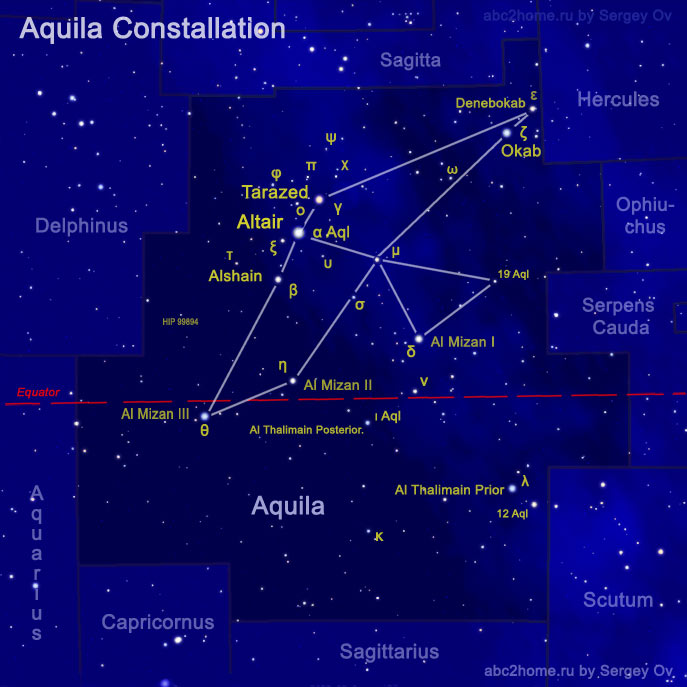
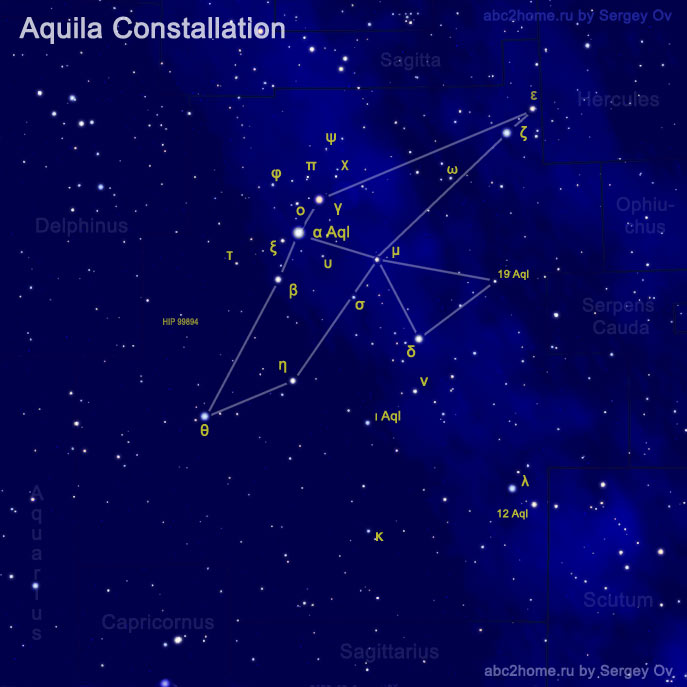
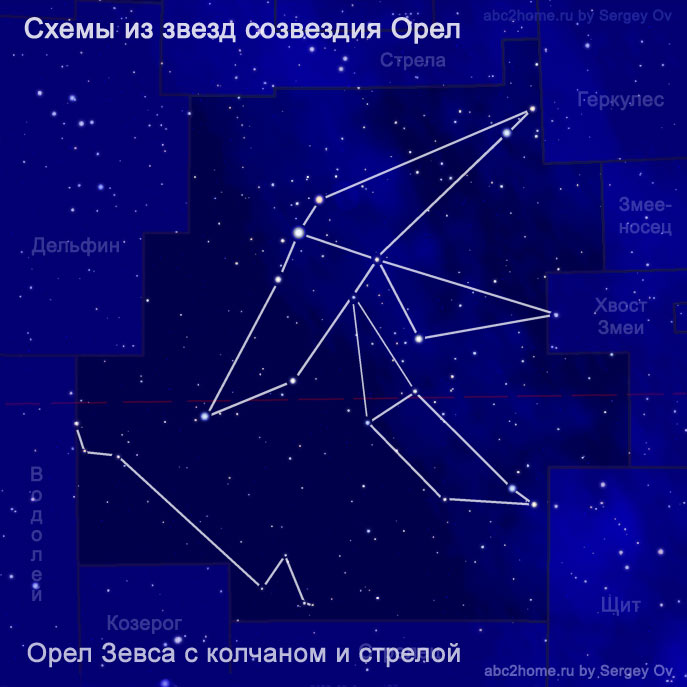
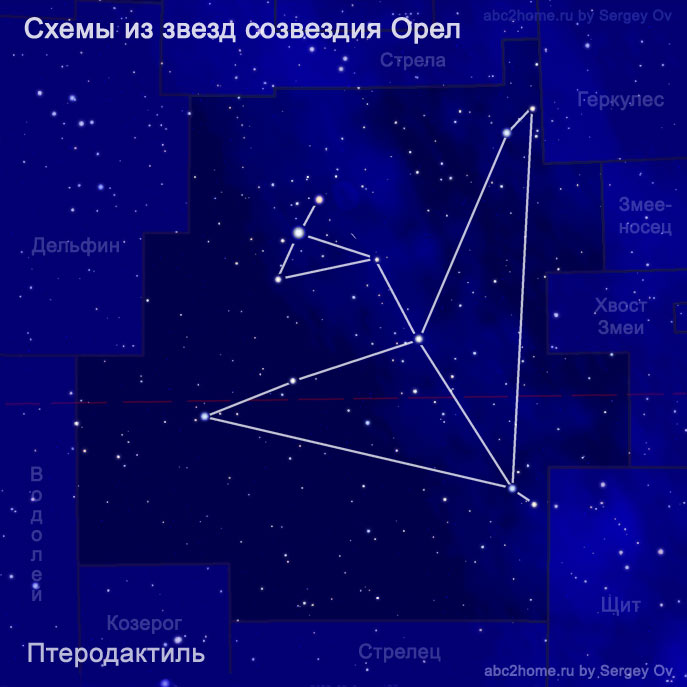
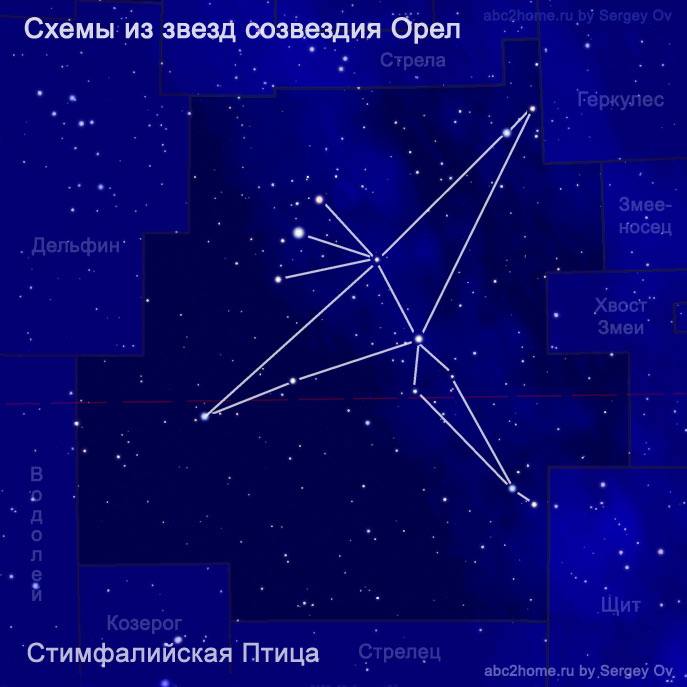
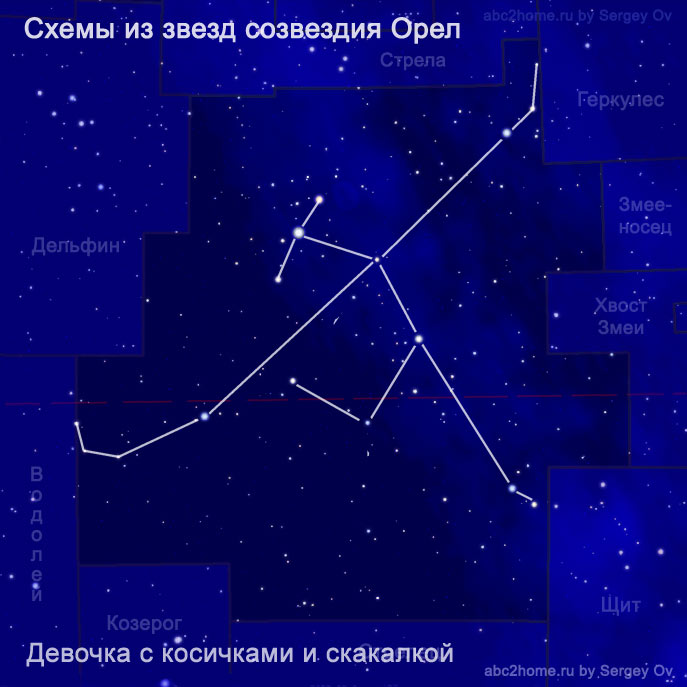
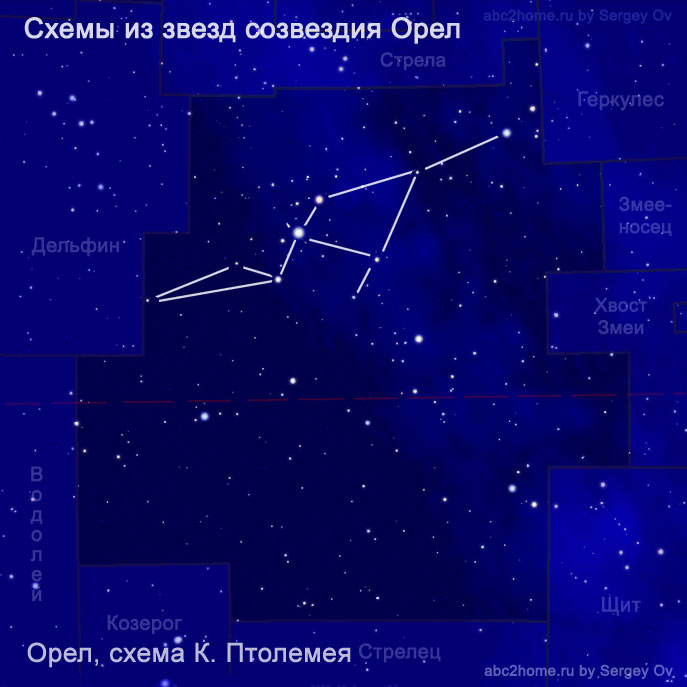
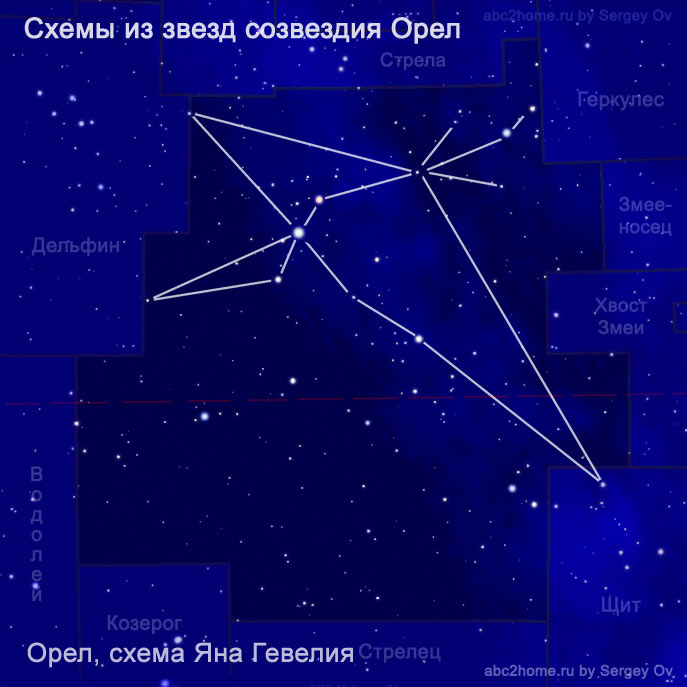
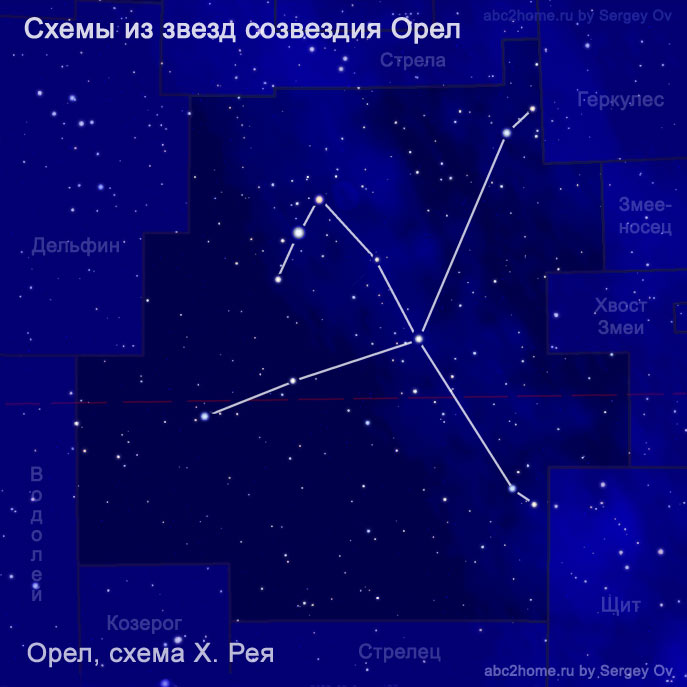
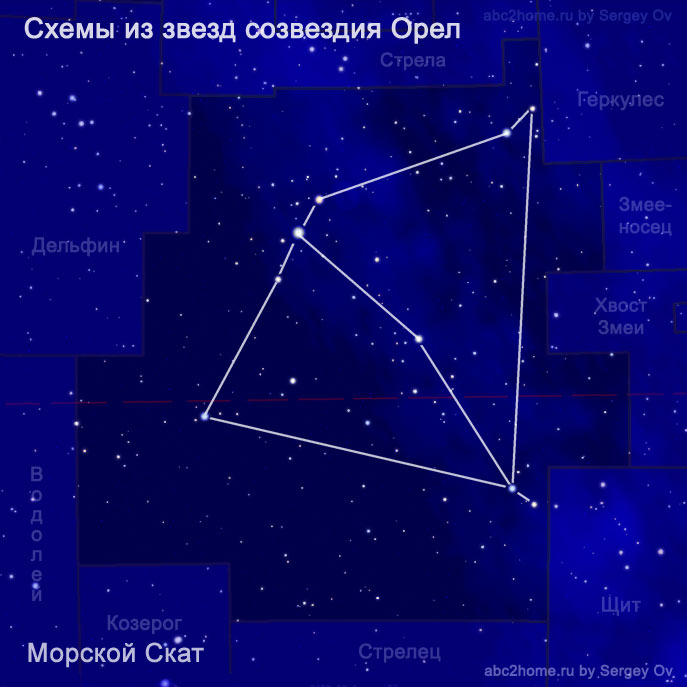
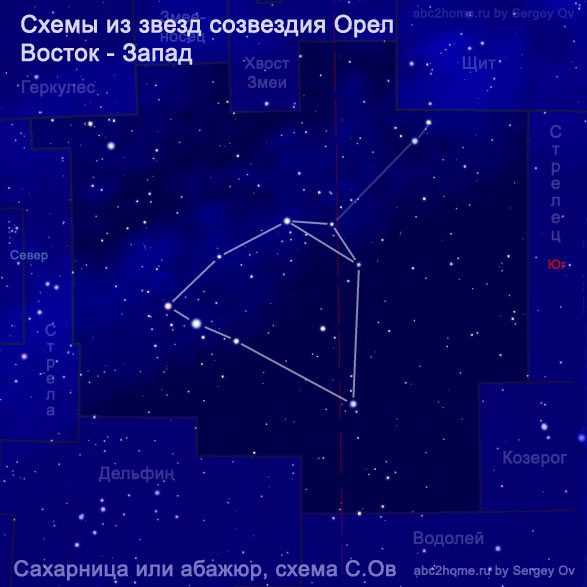
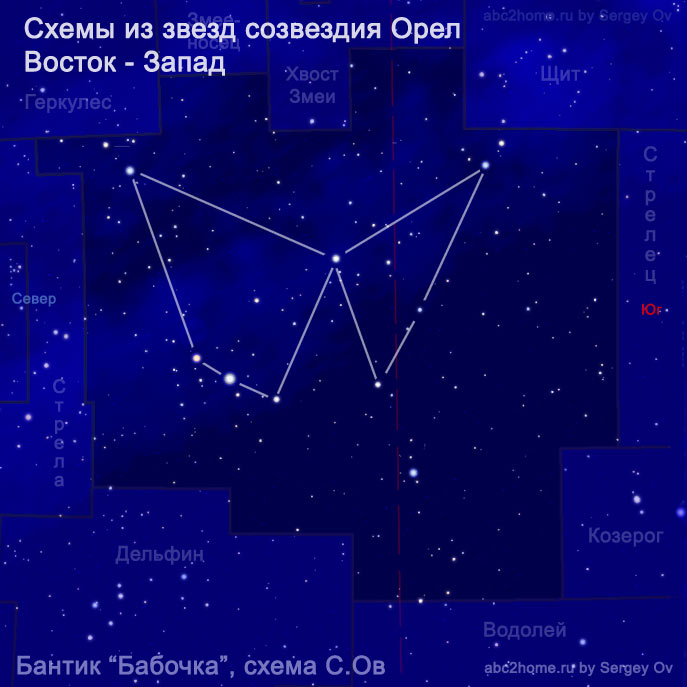
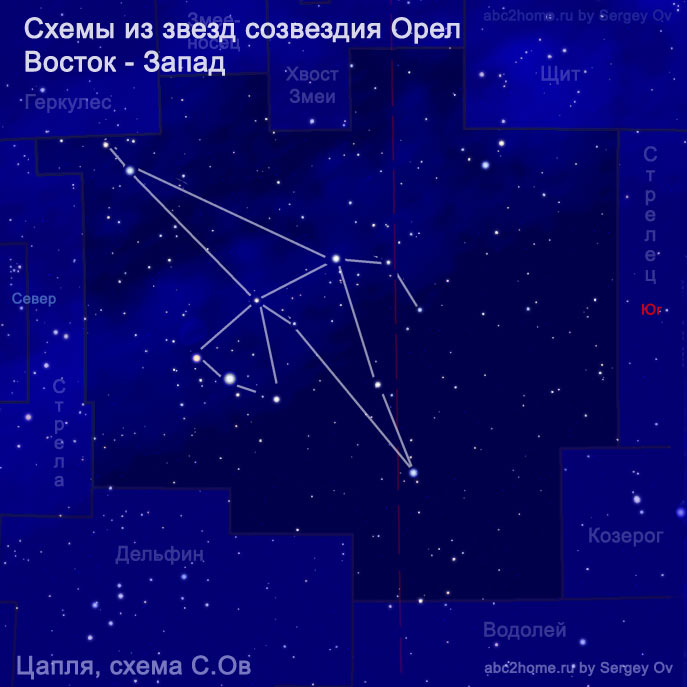
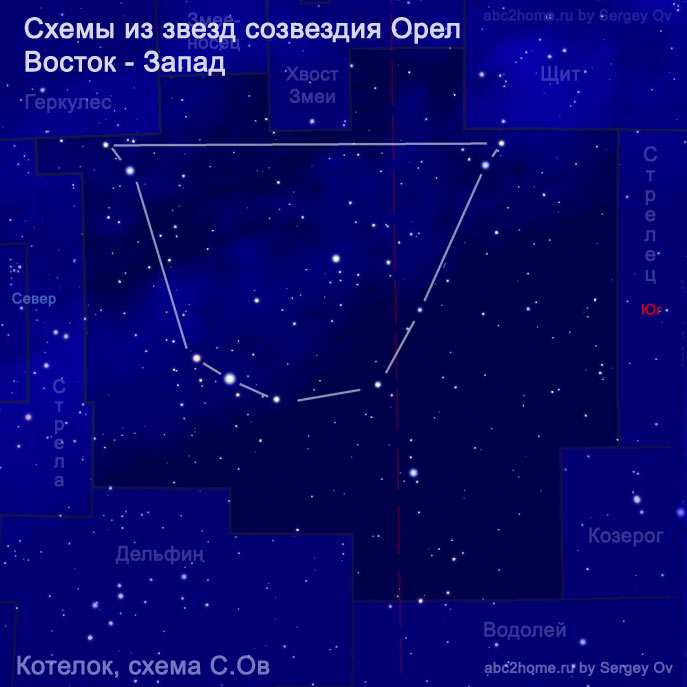
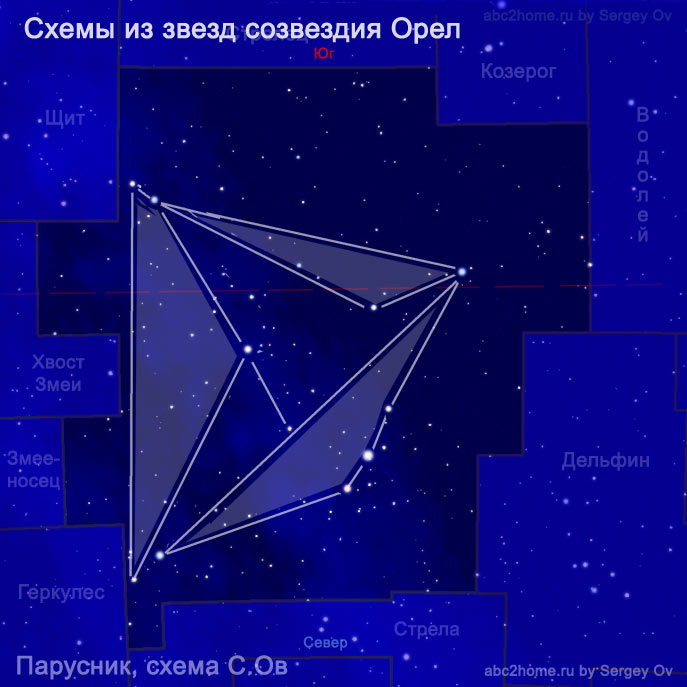
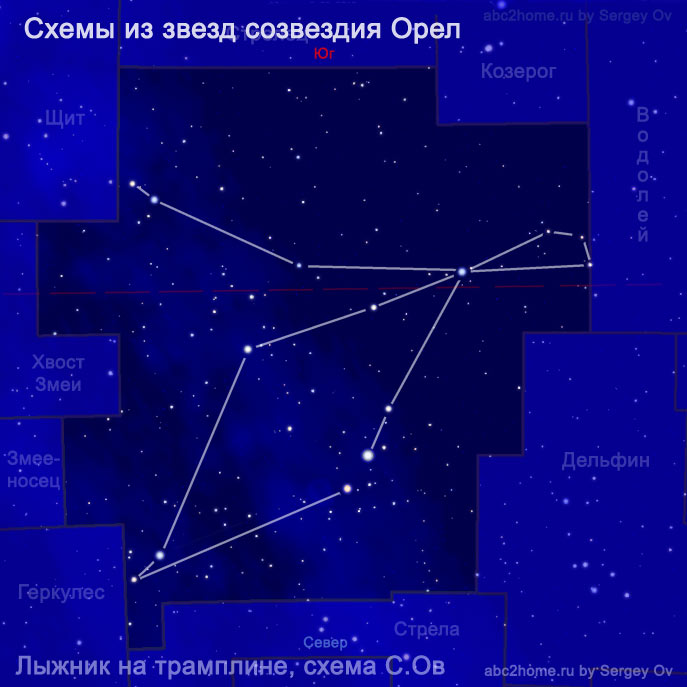
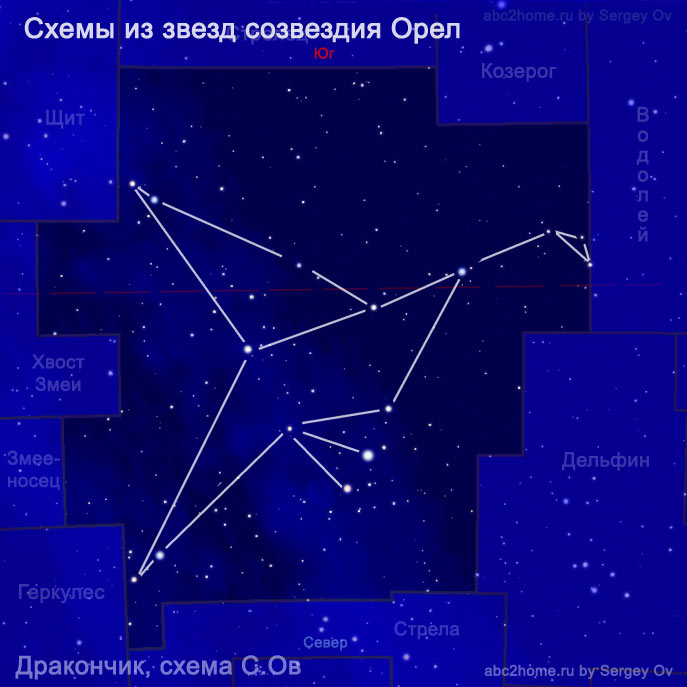
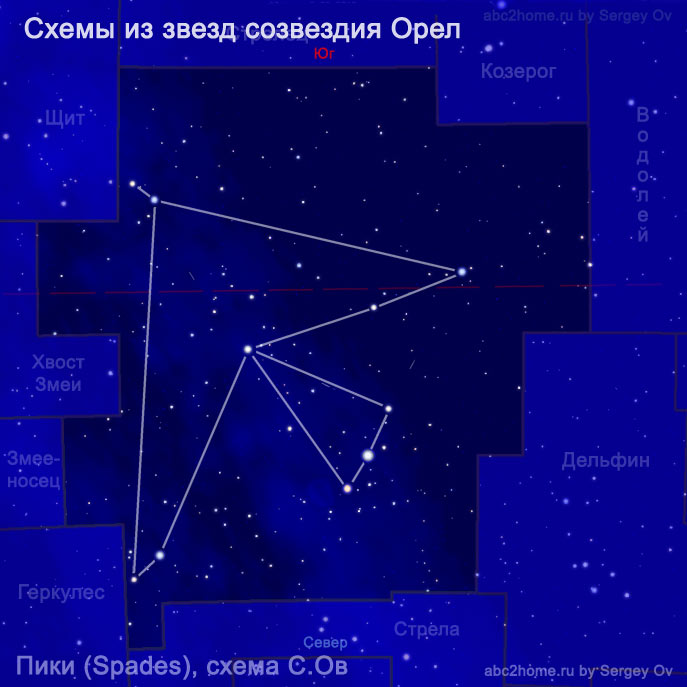
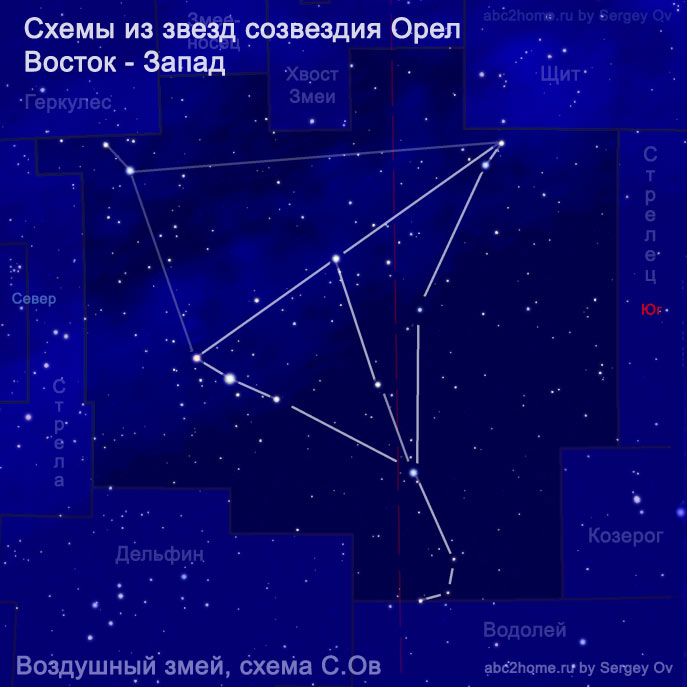
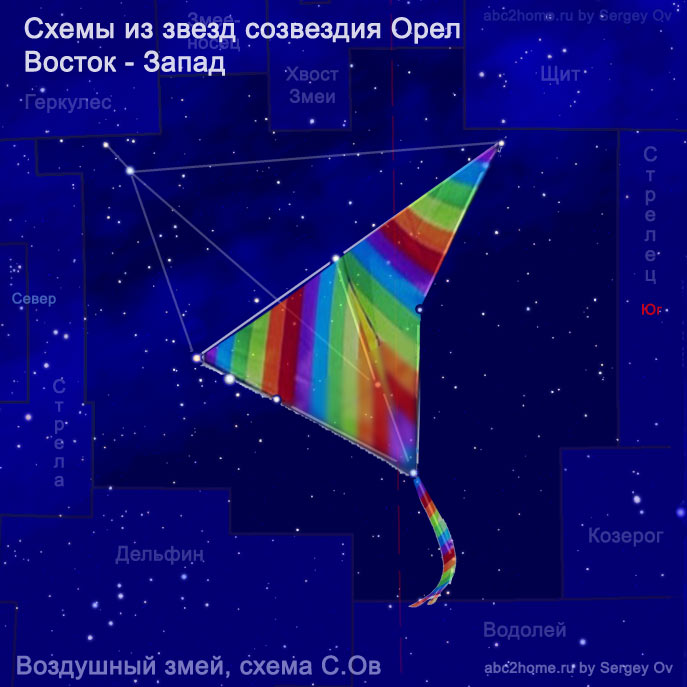
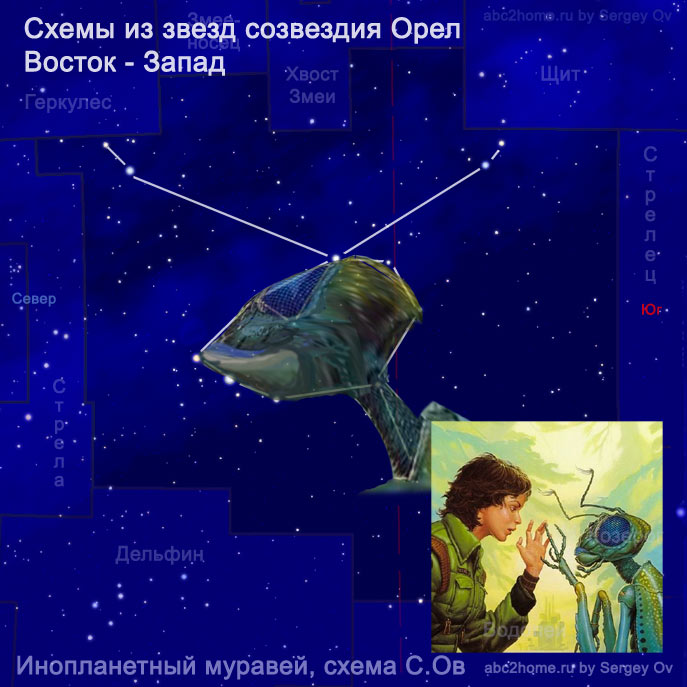
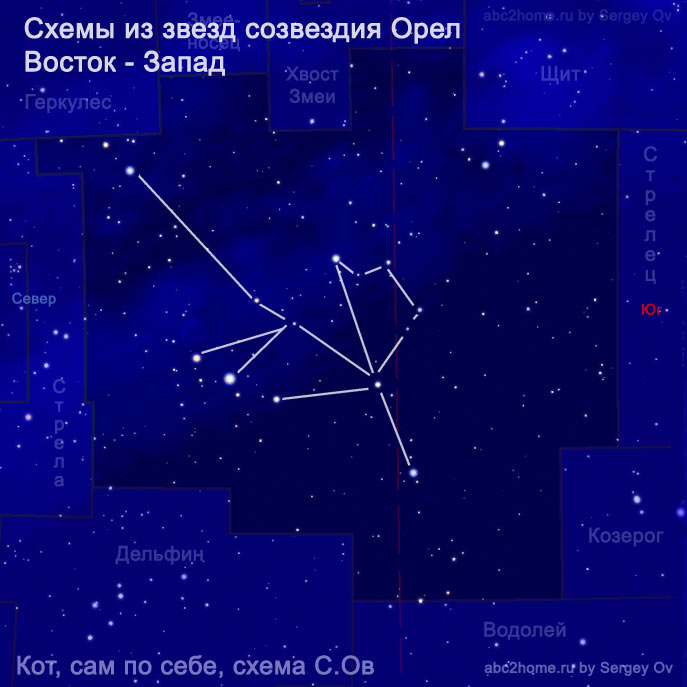
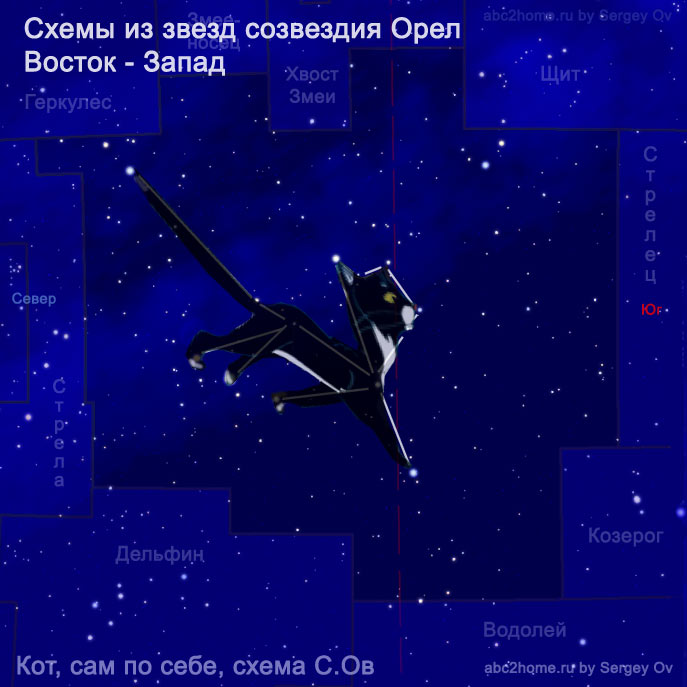
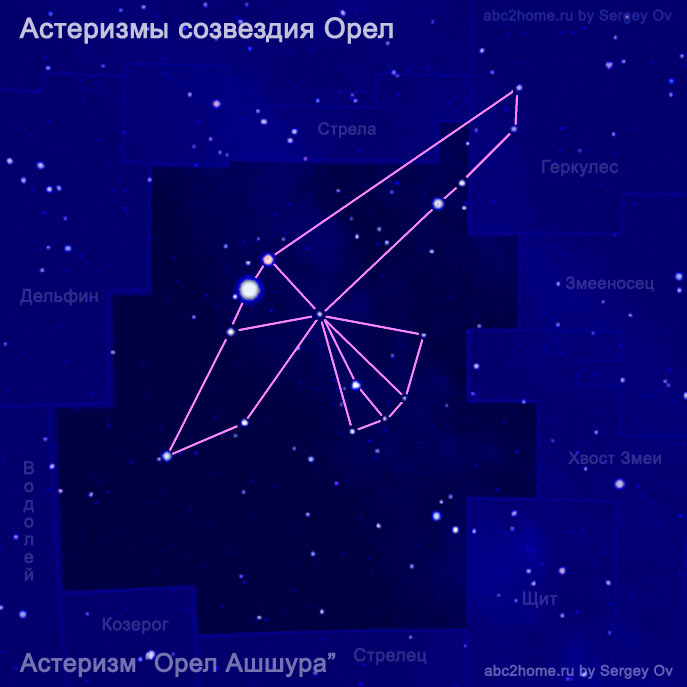
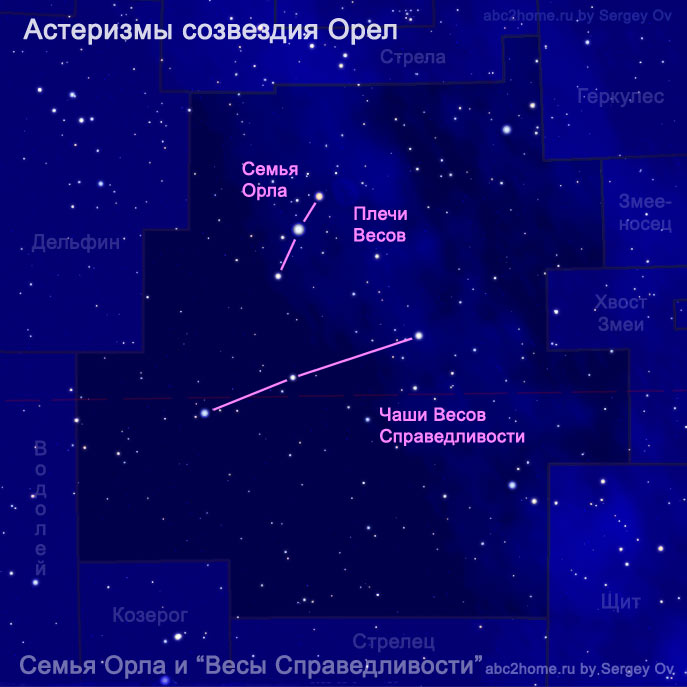
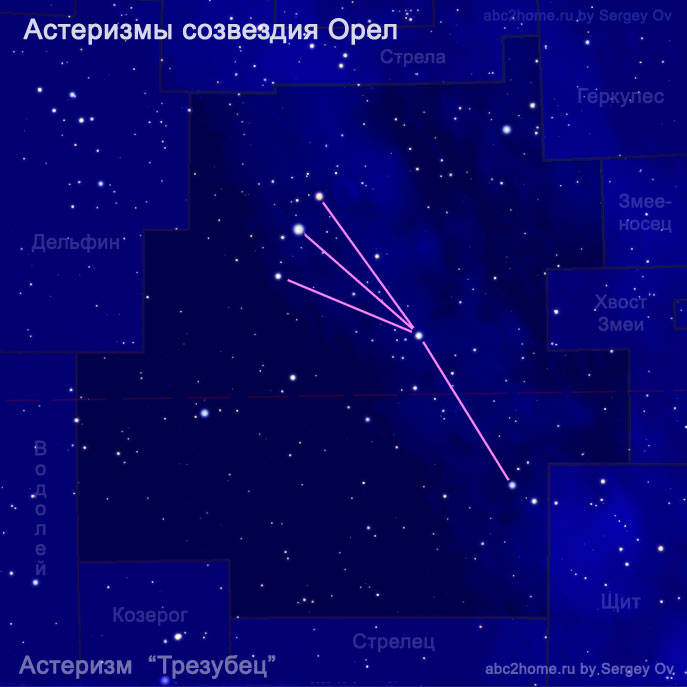
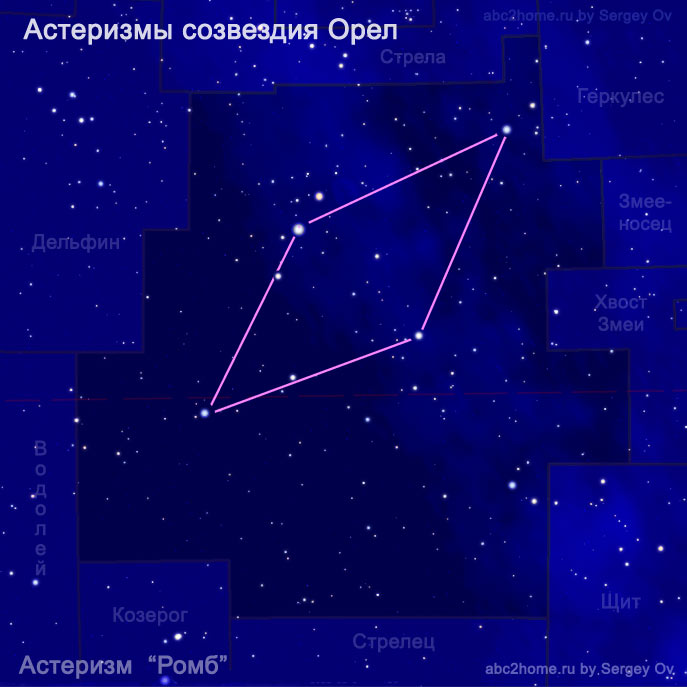
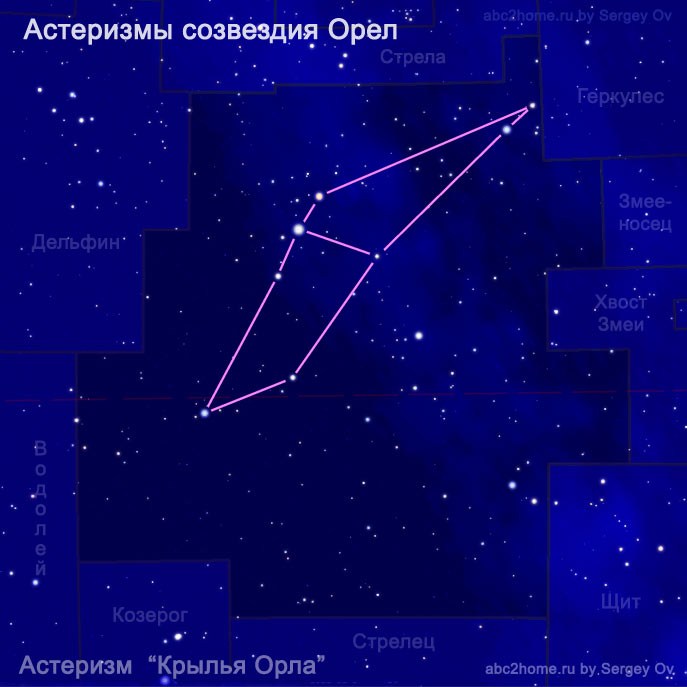
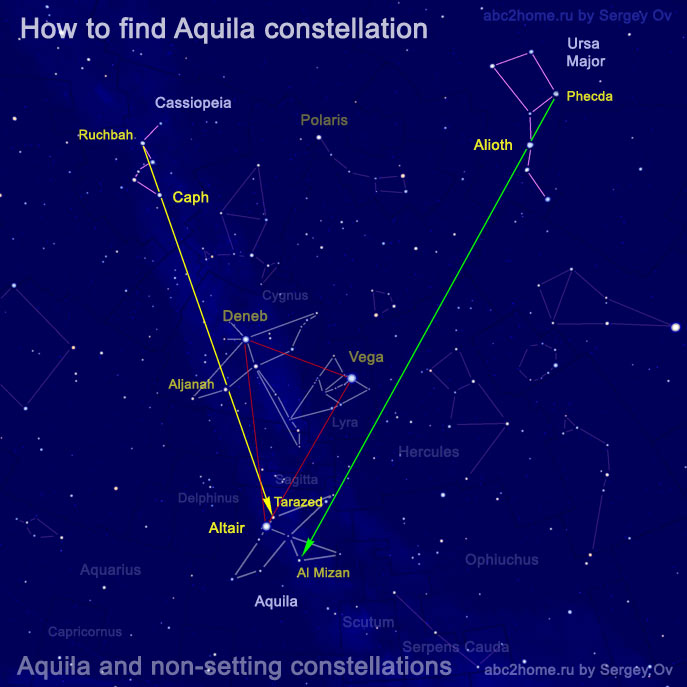
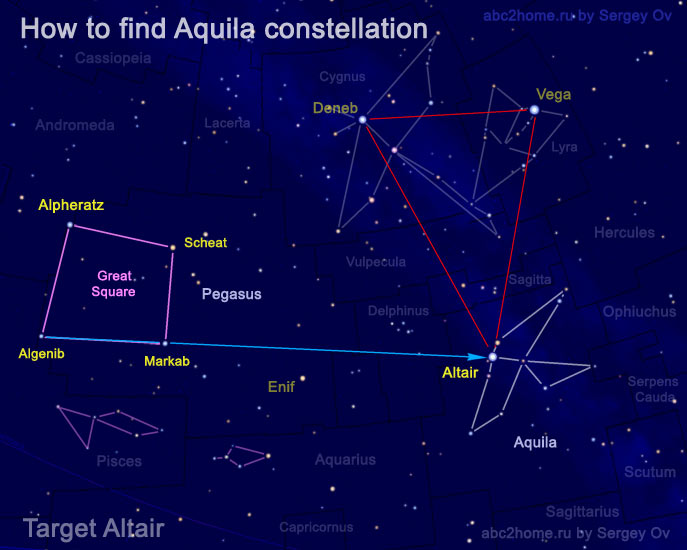
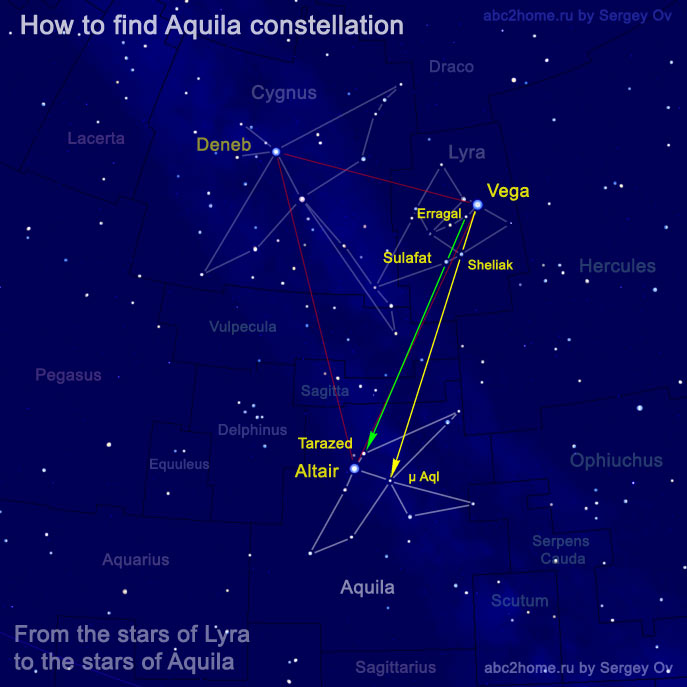
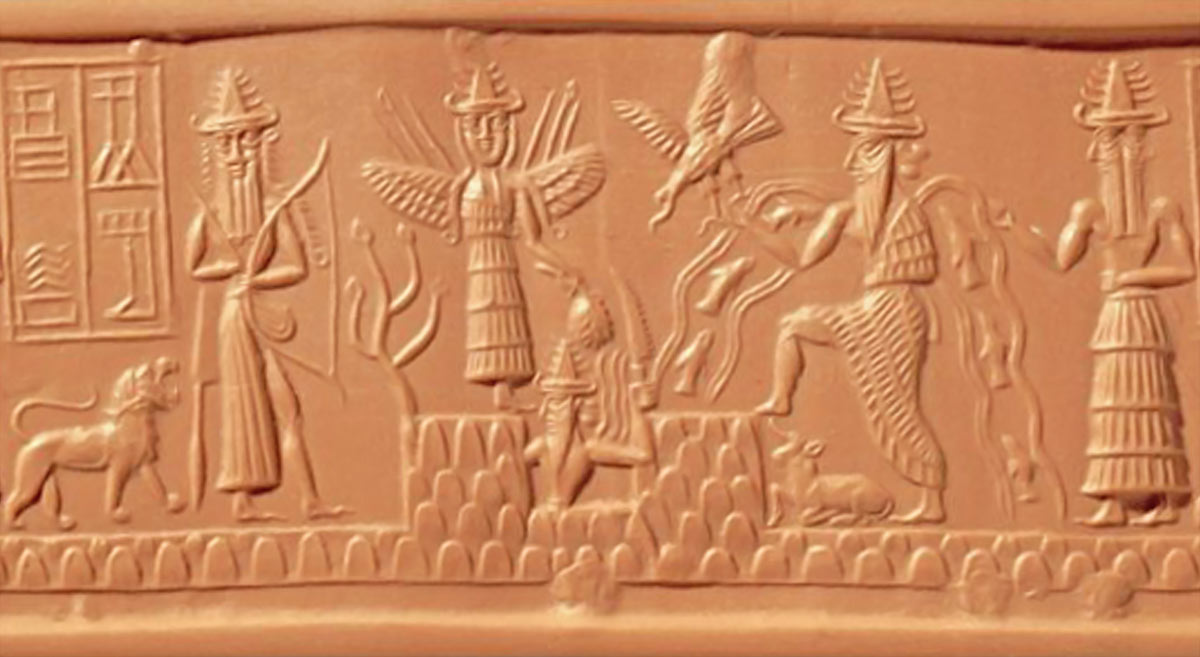
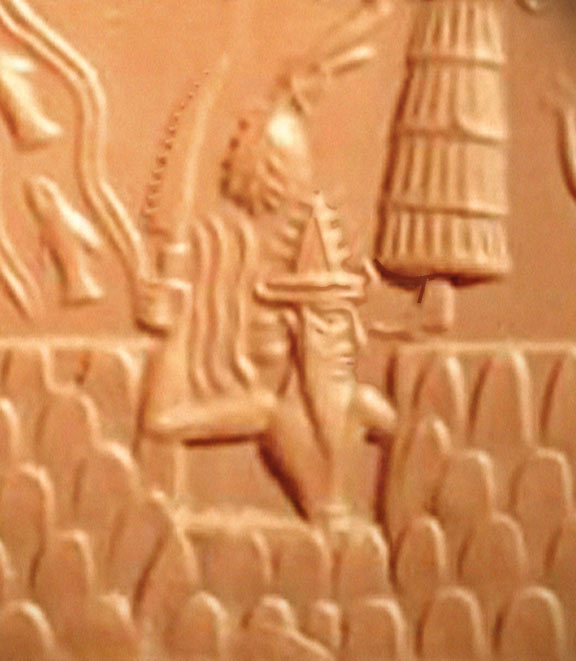
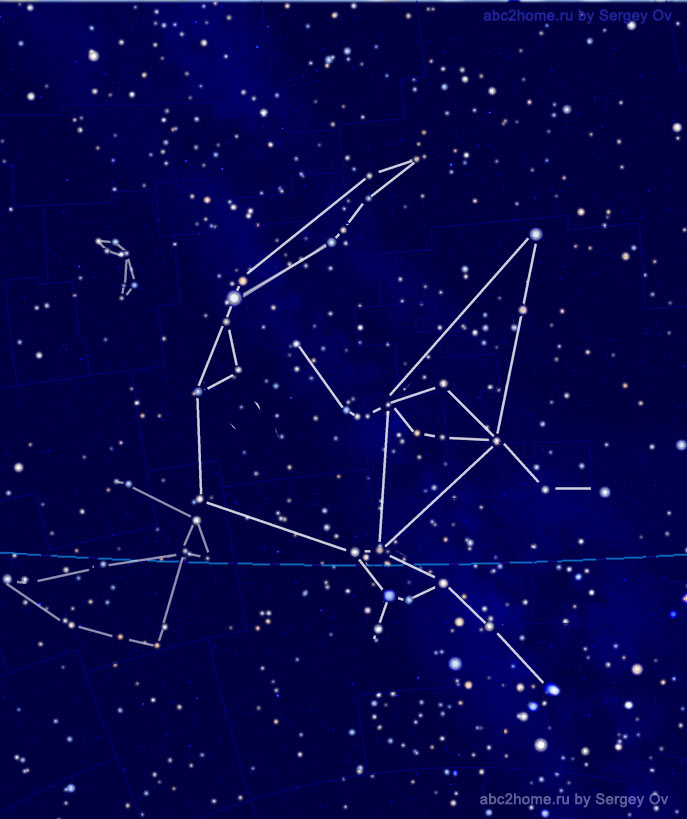
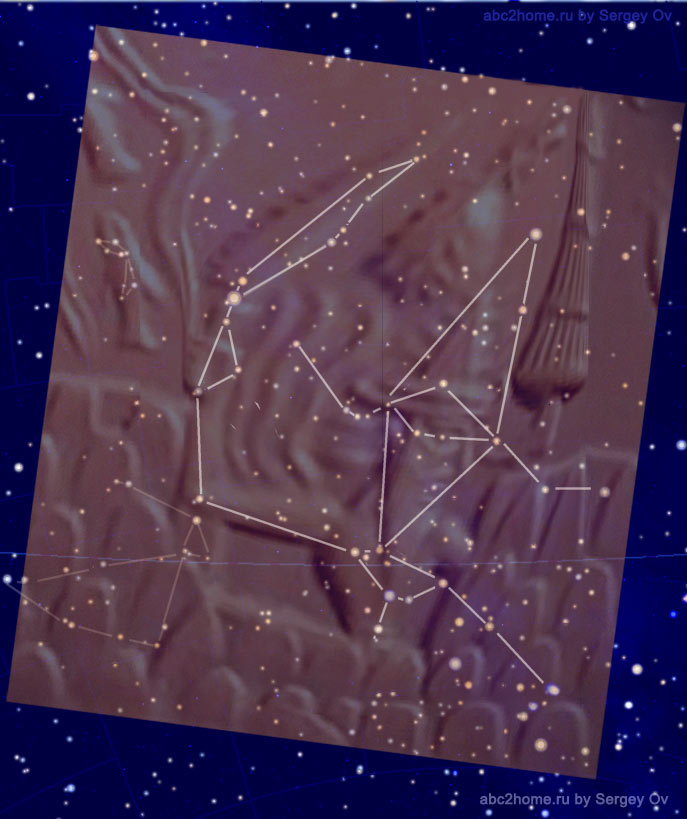
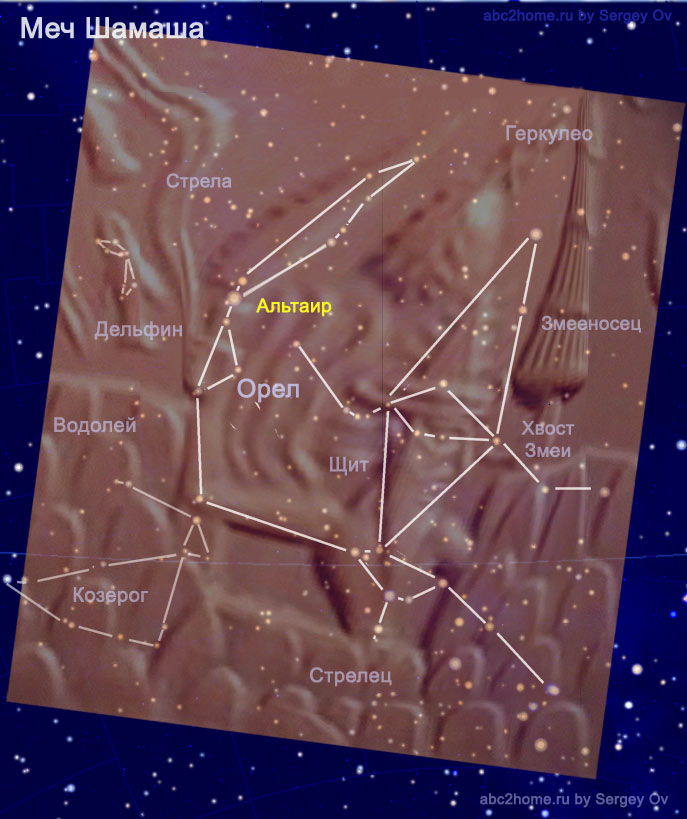
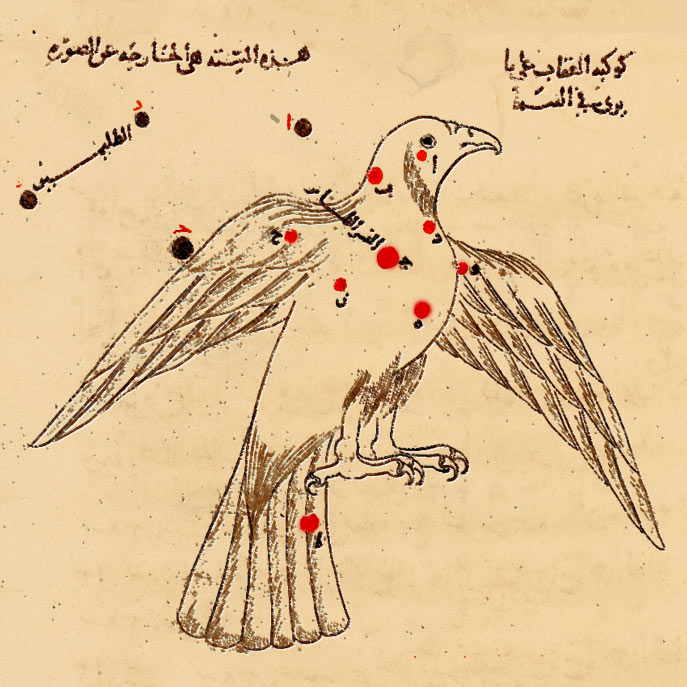
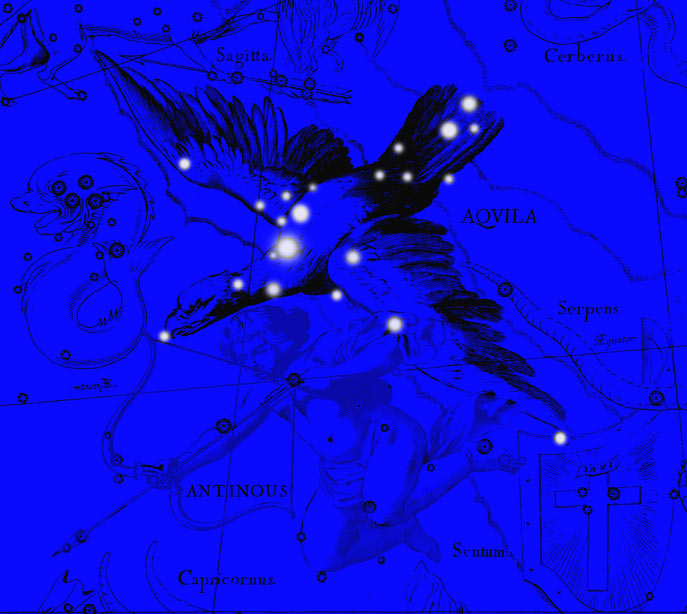
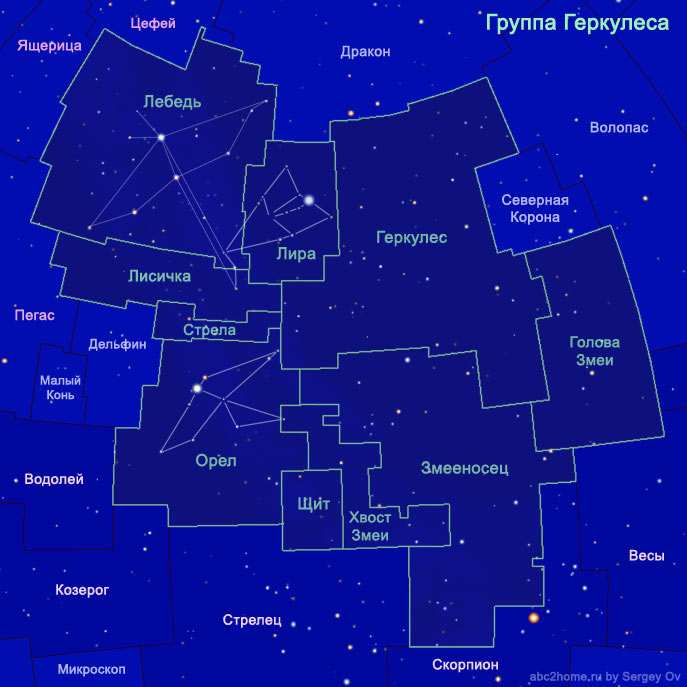
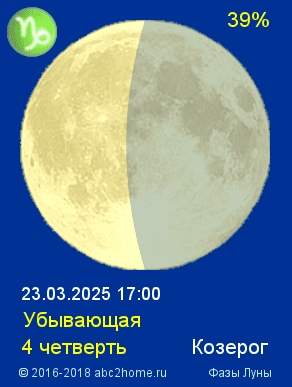


 SIGN ARIES
SIGN ARIES